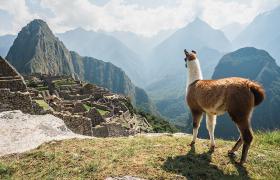South America is becoming increasingly popular for Kiwi travellers. The cities and landscapes appeal to backpackers, adventurers and explorers alike, and the locals are ready to welcome you with open arms (and an empanada or two).
Travellers will often visit more than one country in South America, which can add a specific layer of confusion when it comes to foreign currency and travel money norms.
We want your South American adventure to be a breeze, which is why we’ve compiled a handy guide to what currency can be used where, as well as a few tips and tricks on how to make the most of your travel money.
South American Currency Guide
Let’s start with the basics. In South America, there are:
- 12 countries and three major territories
- 12 currencies in use
We should also mention that some of the currencies can’t be sourced outside of their respective country. Confused yet? No worries, just reference this handy little guide.
Cash use in South America
Country not featured? That means they accept USD as the primary form of payment!
Some places make their currencies pretty darn hard to find outside of the nation’s borders. But if you come prepared with some US cash in hand, you can trade to the local currency as you arrive. Just make sure you don’t buy too much and get caught with a currency you don’t need as you leave!
Here are some tips for cash use regardless of what country you’re in:
- Make sure the US bills are crisp and not wrinkled or torn, especially in Bolivia and Peru. If you get given a note that isn’t up to standard, don’t be afraid to ask for another.
- Double-check bills and coins when exchanging money. Fraud is not uncommon in South America, and you don’t want to be caught out with fake money.
- It’s best to use the local currency for smaller daily payments
- Have small denominations on hand for street vendors and smaller shops
- Tipping isn’t always expected, but between 10-15% is appreciated, especially for tour guides.
- Petty theft is common in South America, so don’t have all of your cash in one spot. Keeping some in your sock might sound crazy, but it is guaranteed to be there and get you out of tricky situations if necessary.
Card use in South America
Cash is king throughout South America, especially in more remote regions like Patagonia and Galapagos. With this in mind, it is still wise to have plenty of travel money options available to you. This is particularly the case if you are moving between a few different nations.
We recommend loading up a Cash Passport with either USD or NZD and then withdrawing cash as necessary in South America.
When it comes to withdrawing cash, ATMs can be a bit hit and miss. In the major cities, ATMs are not hard to find, though in some countries they are renowned for running out of cash or breaking down. Aim to use ATMs in banks as they are the safest option. ATMs in stores are also fine, though they may charge more exorbitant fees, so keep an eye out to avoid paying more than necessary.
Travel Money Tips for South American Countries
|
Argentina |
Argentina is one of four South American countries that charge Kiwi’s a reciprocity fee of US$100 for entering the territory. |
|
Bolivia |
Card is only really accepted at upscale establishments like hotels and restaurants. Make sure you have cash on hand, paying special attention to the quality of your USD bills. |
|
Brazil |
ATMs are super easy to find - even in small villages! Some don’t accept foreign bank cards though, and they will often close from 10pm to 6am. |
|
Chile |
If you’re venturing into more rural areas, keep in mind that stores might not have enough change for larger banknotes. |
|
Colombia |
The Colombian peso is the only currency accepted in Colombia, and exchanges aren’t always easy. Visit an official exchange bank instead of a regular bank to get your foreign cash. |
|
Ecuador |
USD notes are used widely in Ecuador, however you may get Ecuadorian change. |
|
Guyana |
You’ll often find the best exchange rate at ‘cambios’ in Guyana. |
|
Paraguay |
Most shops prefer cash, with very few accepting credit cards. When using cash, the smaller denominations are rarely used as they have very little value. |
|
Peru |
In the Miraflores District of Lima, the men you see standing in the street with bright blue jackets are legit money changers. |
|
Suriname |
ATMs from the Republic Bank tend to accept the most international bank cards, so look out for them if you need more cash. |
|
Uruguay |
ATMs marked with a green ‘Banred’ or blue ‘Redbrou’ logos serve all major international banking networks. The only catch - most will have a US$300 daily withdrawal limit per card. |
|
Venezuela |
The foreign currency black market is rife in Venezuela, so ask your hotel or accommodation for recommended money traders in order to get the best and safest deal. |
Need a little more advice on travel or foreign currency? Our Travel Money experts are available in-store seven days a week. Better yet, when you’re ready to go order your currency through our website and pick it up from your nearest store when it’s available!
This blog is provided for information only and does not take into consideration your objectives, financial situation or needs. You should consider whether the information and suggestions contained in any blog entry are appropriate for you, having regard to your own objectives, financial situation and needs. While we take reasonable care in providing the blog, we give no warranties or representations that it is complete or accurate, or is appropriate for you. We are not liable for any loss caused, whether due to negligence or otherwise, arising from use of, or reliance on, the information and/or suggestions contained in this blog.














